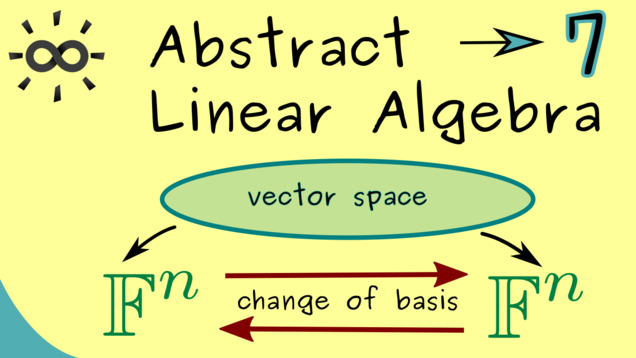
-
Title: Change of Basis
-
Series: Abstract Linear Algebra
-
Chapter: General vector spaces
-
YouTube-Title: Abstract Linear Algebra 7 | Change of Basis
-
Bright video: https://youtu.be/qHFTPzUzc5s
-
Dark video: https://youtu.be/MIh5V14twLU
-
Quiz: Test your knowledge
-
Dark-PDF: Download PDF version of the dark video
-
Print-PDF: Download printable PDF version
-
Thumbnail (bright): Download PNG
-
Thumbnail (dark): Download PNG
-
Subtitle on GitHub: ala07_sub_eng.srt missing
-
Timestamps
00:00 Introduction
00:44 Two bases for a vector space
02:53 Change of basis
03:20 Basis isomorphism properties
04:13 Example (change of basis in polynomial space)
07:35 Switching from old to new coordinates
09:35 Change of basis is a linear map
10:57 Credits
-
Subtitle in English (n/a)
-
Quiz Content
Q1: Let $V = \mathcal{P}2$ be the vector space of polynomials with degree less or equal than $2$ and $\mathcal{B} = (m_0, m_1, m_2)$ be the standard monomial basis. What is $\Phi{\mathcal{B}}(p)$ if $p$ is the polynomial $p(x) = x^2 - x^1 +8$?
A1: $\begin{pmatrix} 8 \ -1 \ 1 \end{pmatrix}$
A2: $\begin{pmatrix} 1 \ -1 \ 8 \end{pmatrix}$
A3: $\begin{pmatrix} -1 \ 1 \ 8 \end{pmatrix}$
A4: $\begin{pmatrix} 8 \ 1 \end{pmatrix}$
Q2: Let $V = \mathcal{P}_2$ be the real vector space of polynomials with degree less or equal than $2$ and $\mathcal{B} = (m_0, m_1, m_2)$ be the standard monomial basis. Moreover, let $p(x) = x^2 - x^1 +8$ be a polynomial and $\mathcal{C} = (m_0, m_1, p)$ be another basis. What is correct for the polynomial $q(x) = x^2$
A1: $\Phi_{\mathcal{B}}(q) = \begin{pmatrix} 0 \ 0 \ 1 \end{pmatrix}$ and $\Phi_{\mathcal{C}}(q) = \begin{pmatrix} -8 \ 1 \ 1 \end{pmatrix}$
A2: $\Phi_{\mathcal{B}}(q) = \begin{pmatrix} 8 \ -1 \ 1 \end{pmatrix}$ and $\Phi_{\mathcal{C}}(q) = \begin{pmatrix} 0 \ 1 \ 1 \end{pmatrix}$
A3: $\Phi_{\mathcal{B}}(q) = \begin{pmatrix} 8 \ 1 \ -1 \end{pmatrix}$ and $\Phi_{\mathcal{C}}(q) = \begin{pmatrix} 0 \ 1 \ 1 \end{pmatrix}$
A4: $\Phi_{\mathcal{B}}(q) = \begin{pmatrix} 0 \ 1 \ 1 \end{pmatrix}$ and $\Phi_{\mathcal{C}}(q) = \begin{pmatrix} 8 \ -1 \ 1 \end{pmatrix}$
Q3: Let $V$ be an $n$-dimensional vector space and $\mathcal{B}$ and $\mathcal{C}$ be two bases in $V$. How is the change of basis map $f$ for going from $\mathcal{B}$ to the new basis $\mathcal{C}$ defined?
A1: $f: \mathbb{F}^n \rightarrow \mathbb{F}^n$ given by $f(x) = \Phi_{\mathcal{C}} \Phi_{\mathcal{B}}^{-1}(x)$
A2: $f: \mathbb{F}^n \rightarrow \mathbb{F}^n$ given by $f(x) = \Phi_{\mathcal{B}} \Phi_{\mathcal{C}}^{-1}(x)$
A3: $f: \mathbb{F}^n \rightarrow \mathbb{F}$ given by $f(x) = \Phi_{\mathcal{B}} \Phi_{\mathcal{B}}^{-1}(x)$
A4: $f: \mathbb{F} \rightarrow \mathbb{F}^n$ given by $f(x) = \Phi_{\mathcal{B}} \Phi_{\mathcal{C}}^{-1}(x)$
-
Last update: 2024-11